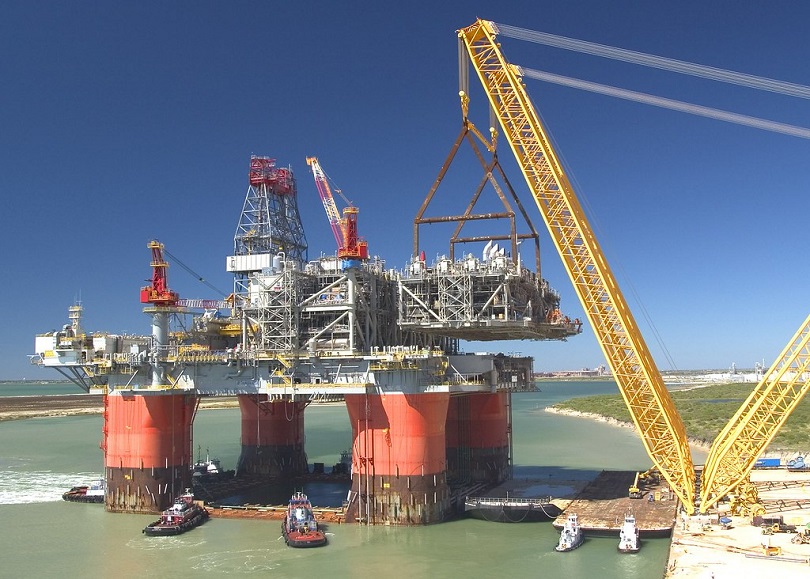In the vast expanse of the ocean, the semi-submersible oil rig represent a triumph of engineering, serving as crucial tools in offshore oil exploration. These colossal structures are a symphony of interconnected components, each meticulously designed to withstand the challenges of the open sea while extracting valuable resources from beneath the ocean floor. This article dives deep into the main parts of a semi-submersible oil rig, shedding light on its complexity, with a particular focus on the moon pool and bridge.
Semi-Submersible Oil Rig – Main Parts
Substructure:
At the heart of a semi-submersible oil rig lies the substructure, a massive foundation that anchors the rig to the seabed, providing unwavering stability. Constructed from heavy-duty steel, the substructure’s columns and pontoons extend both above and below the waterline, ensuring stability in turbulent sea conditions.
Helideck platform:
One of the most essential parts of the platform, the helideck is used not only for the crew changes but as well as part of the emergency protocol and medvac procedure.

Pontoons:
Buoyant pontoons are integral to the semi-submersible oil rig’s design, contributing significantly to its buoyancy and allowing it to remain afloat. Ballasted with water or air for depth control, pontoons play a vital role in the rig’s ability to adjust its position, providing stability against the relentless forces of the ocean.

Columns:
Rising from the pontoons, robust columns provide elevation for various facilities, including crew quarters, control rooms, and machinery spaces. These columns must withstand dynamic forces from wind, waves, and drilling operations, ensuring the semi-submersible oil rig’s structural integrity.

Deck:
Perched atop the columns, the deck is the rig’s operational hub, housing the drilling derrick, equipment storage, risers, and machinery for extracting oil and gas. It is a bustling platform for drilling activities and other essential operations that keep the rig productive.
Drilling Derrick:
The iconic drilling derrick, towering above the deck, houses the drilling equipment, including the drilling rig, hoisting system, and other tools. This structure provides the necessary height for drilling deep into the Earth’s crust, reaching oil reservoirs beneath the ocean floor.

Mooring System:
To maintain its position, the rig employs a sophisticated mooring system with anchors and cables, securing it against the forces of nature. This system adapts to varying sea conditions, ensuring the rig remains steadfast over the drilling site.
Dynamic Positioning System:
Complementing the mooring system, the dynamic positioning system enhances the rig’s maneuverability using thrusters. This system allows precise positioning without traditional anchoring, making it indispensable for deep-sea drilling in diverse offshore environments.
Living Quarters:
Beyond its operational functions, the rig serves as a temporary home for the crew. Living quarters on the rig offer essential amenities, including sleeping areas, dining spaces, and recreation facilities, ensuring the well-being of the personnel during extended stays.
Moon Pool:
A crucial feature, the moon pool is an opening in the rig’s deck that allows drilling equipment to be lowered into the water. This facilitates drilling directly through the rig, providing a direct path to the ocean floor. The moon pool is a vital conduit for extracting resources efficiently.

Navigation Bridge:
Serving as the nerve center of the rig, the bridge is a control hub where navigation and operational decisions are made. Situated high above the deck, the bridge provides a commanding view of the surroundings and facilitates communication, ensuring seamless coordination during drilling and exploration activities.

Mud Processing and Mud Pits:
Essential to drilling operations, mud processing involves the circulation and purification of drilling mud – a mixture of water, clay, and chemicals.
Mud pits, strategically located on the rig, serve as reservoirs for the mud. This process maintains stability in the wellbore, cools and lubricates the drill bit, and carries rock cuttings to the surface.
Efficient mud processing, facilitated by the mud pits, is crucial for successful and safe drilling operations.

In the relentless pursuit of energy resources, semi-submersible oil rigs emerge as a testament to human ingenuity. From the robust substructure to the towering drilling derrick, each component, including the moon pool and navigation bridge, contributes to the rig’s efficiency and adaptability in the challenging environment of the open sea. These technological marvels continue to push the boundaries of exploration, extracting invaluable resources from the depths to power our world. Of course there are many other parts of an semi-submersible oil rig which could be listed, like the cranes on main deck, whiteout which the activity onboard could not be done, however on this article I will resume only to the ones above.
